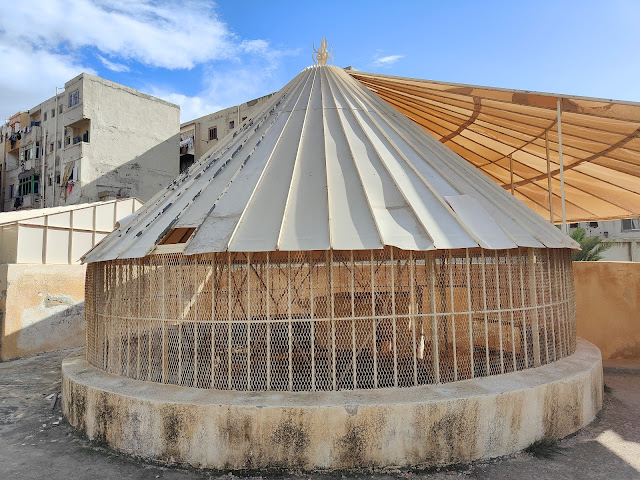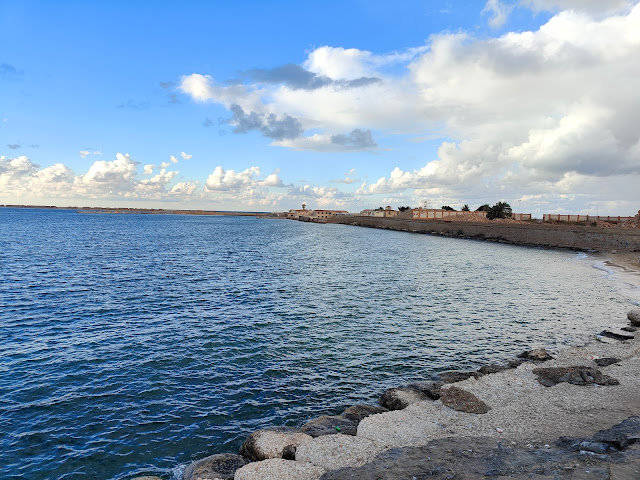In which I explored the jewel of Egypt
12.12.2023: Tour Day 1, City 1
Egypt (called Miṣr in Arabic) is a transcontinental country spanning the northeast corner of Africa and the Sinai Peninsula in the southwest corner of Asia. It is bordered by the Mediterranean Sea to the north, the Gaza Strip of Palestine and Israel to the northeast, the Red Sea to the east, Sudan to the south, and Libya to the west. We were a bunch of 28 travellers to explore the African part and let me assure you that this country is beyond mummies and pyramids. After a 3 hour drive from Cairo, we entered Alexandria, a Mediterranean port city in Egypt, founded by Alexander. We reached our first sightseeing location at noon, passing through the narrow lane roads and receiving smiles and hellos from the locals. We got the tickets checked and entered the premises.
Catacombs of Kom El Shoqafa
A catacomb is human-made subterranean passageways for religious practice and burials. This catacomb is composed of a ground level construction that probably served as a funerary chapel, a deep spiral stairway and three underground levels for the funerary ritual and entombment.
The first level consists of a vestibule with a double exedra, a rotunda and a triclinium.
The second level was the main tomb, with various surrounding corridors. It was reached by a monumental staircase from the rotunda.
The third level is submerged in ground water, which has also caused it to be saturated with sand. To the left (southeast) of the rotunda the tombs have a funeral banquet hall called a "Triclinium", which sits to a right angle to the vestibule.
At a right angle to the triclinium and on an axis with the vestibule, a wide staircase from the rotunda, which divides to accommodate the prompter's box (a covered shaft to the third lower level), leads down to the second level that contains the Main Tomb.
At the front of the tomb chamber there is a temple-like façade consisting of two columns topped by papyrus, lotus, and acanthus leaves of ancient Egypt and supporting an architrave with a relief of a central winged sun-disk flanked by Horus falcons. A carved Agathodaemon in the form of a snake is flanking both sides of the entrance to the inner tomb. Each snake wears a Roman Caduceus and a Greek Thyrsus as well as the Egyptian Pschent and is topped by a shield showing a Medusa.
Figures of a man and a woman are carved into the wall. The man's body has a stiff hieratic pose typical of Ancient Egyptian sculpture, with the head carved in the lifelike manner of the classic Hellenes. The woman's figure is also rigidly posed but bears the Roman hairstyle. There are three huge stone sarcophagi with non-removable covers along the sides of the chamber. It's assumed that bodies were inserted in them from behind, using a passageway which runs around the outside of the funeral chamber. There is a hallway with 91 inch deep walls in the central tomb chamber, with carved recesses, each providing burial space for three mummies. The sarcophagi are decorated with garlands and heads of Greek mythology gods. Each sarcophagus has associated a relief panel. The central panel shows the jackal-headed Anubis wearing Roman soldier garb, who mummifies a body lying on a lion bed. Below the bed are three canopic jars. The lateral panels show the Apis-bull receiving a gift.
Four of us got separated from the group, me, Aboli, Barnali Bhattacharjee and Saurabh Goswami, alongwith Mahendra. We went till the end of the spiral stairs and then back to the top, just to hear out from Ragini Choksi that no one has come upstairs. Then where did all go, we could not even hear anyone or Mohammed. Was there any other exit? We again went downstairs to the rotunda and finally saw all coming out from a passage.
The Hall of Caracalla is actually not considered to be an integral part, but this second system of tombs is entered through a breach in the rock from the first level rotunda. Finally we were back to the bus by 12:50pm and drove ahead for the next location in 10 minutes.
Pompeii Pillar
It is a Roman triumphal column, located on Alexandria's ancient acropolis, adjacent to the city's Arab cemetery—and was originally part of a temple colonnade. Including its pedestal, it is 30 m high; the shaft is of polished red granite, 2.7 m in diameter at the base, tapering to 2.4 m at the top. The shaft is 88 ft high and made out of a single piece of granite and weight approximately 396 tons. We walked through the bridge passing by an eucalyptus tree, to reach the pillar.
Mohammed briefed on the history. We further reached the underground library at 1:30pm and then to the bull status 1:40pm.
It represents the God Serapis, in a shape of a bull. Finally we left the venue at 2pm and had a fantastic treat.
We drove further in this city influenced with Graeco-Roman architecture. We passed by the Roman Amphitheatre at 2:30pm. It is symmetrical with extended wing. The audience section consists of 13 rows.
The uppermost part was a portico which made out of Granite columns. Granite columns brought from Aswan and some of them are still standing until today. Post this we headed for our lunch to the Athineos restaurant. We drove parallel to the Mediterranean sea, just the way we have Marine Drive in Mumbai. Lunch seating was different, the bread/naan was already served on every table. We had to pick rest of the food from the buffet. As usual less-spice food and lentil soup. Most of us were on salads.
It was nice to have a sea view during lunch. We were done with the sight seeing as per the itinerary. Post lunch when we got into the bus, it drizzled for a while. We did stop for clicking some photos on the Mediterranean drive. It was a delight watching the Mediterranean sea from the African side, having watched it from the European side four years back.
We watched the Bibliotheca Alexandrina from outside. Done with breathing in the Vitamin Sea and watching an amazing rainbow till 4pm, we headed over to our hotel finally.
We reached the hotel Romance Alexandria at 5pm. As usual the Christmas theme was applied, we had the welcome drink, gave our passports to Mohammed. My room no was 1112, we got into the room and then the struggle started for charging the mobile phones.
We had to assemble in the reception area for dinner by 7:45pm. Many opted to skip dinner due to the tiredness of the whole day. Few of us braved to take a half an hour drive to the Cicilliano restaurant. The restaurant had a Greek touch. Food again was cold breads, but better than the lunch.
We had to use pepper to compensate with the spicelessness. But the orange fruit was worth relishing. We returned to our hotel by 9:30pm and I slept by 10pm.
































